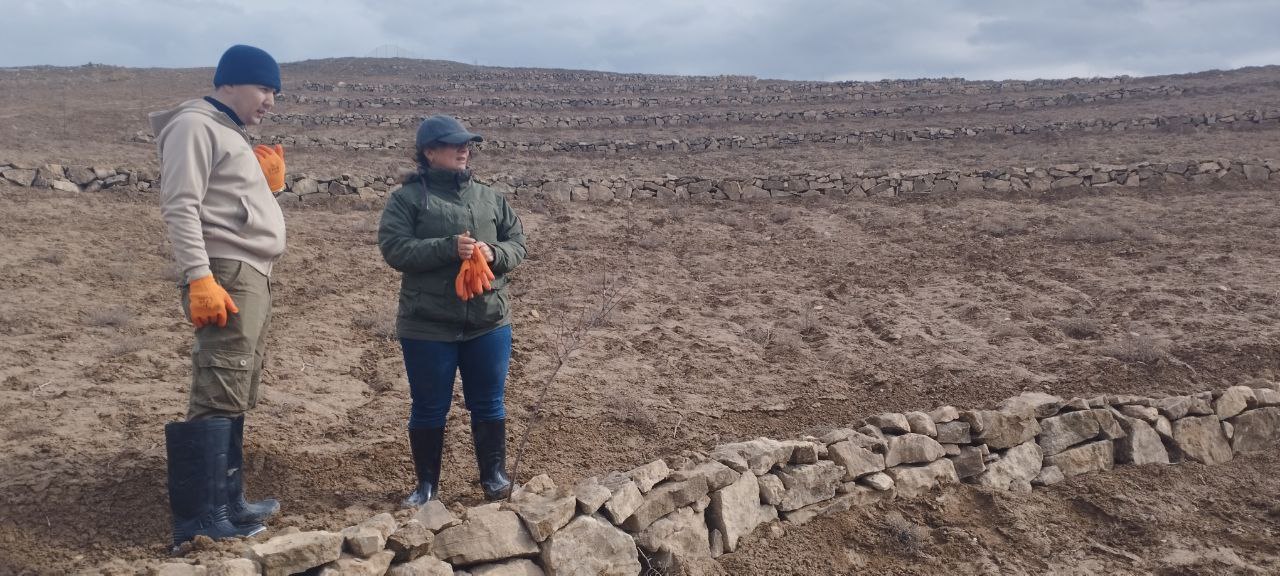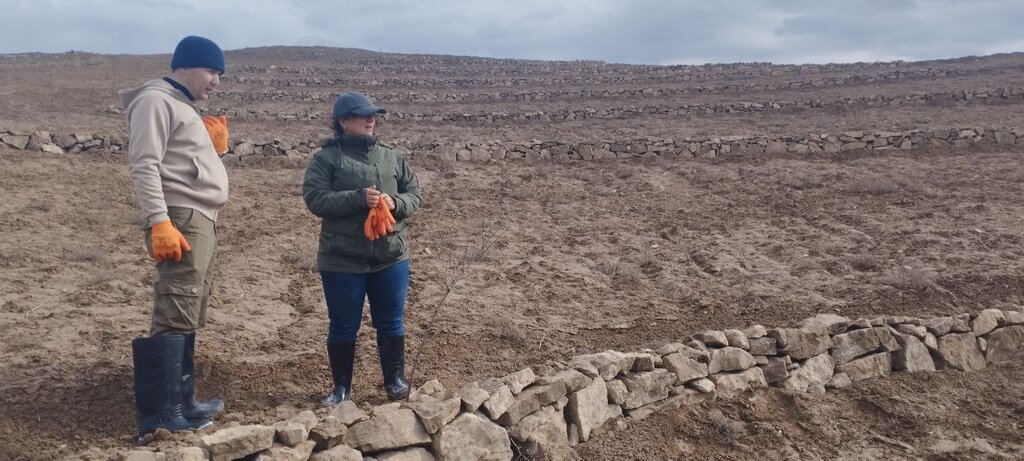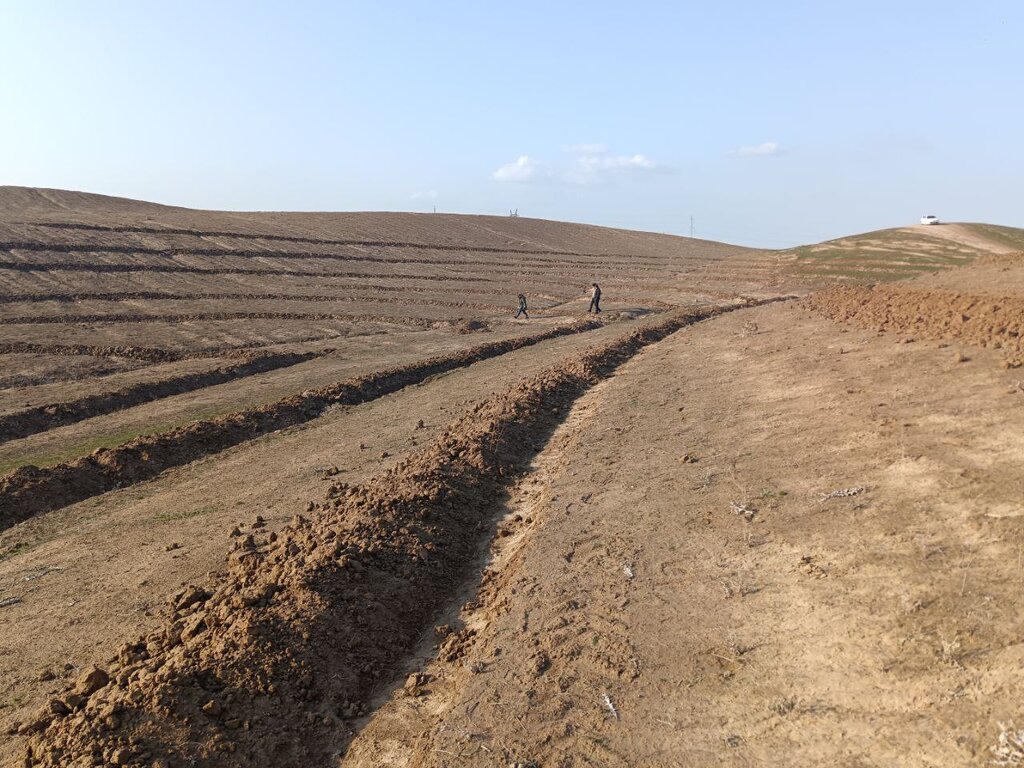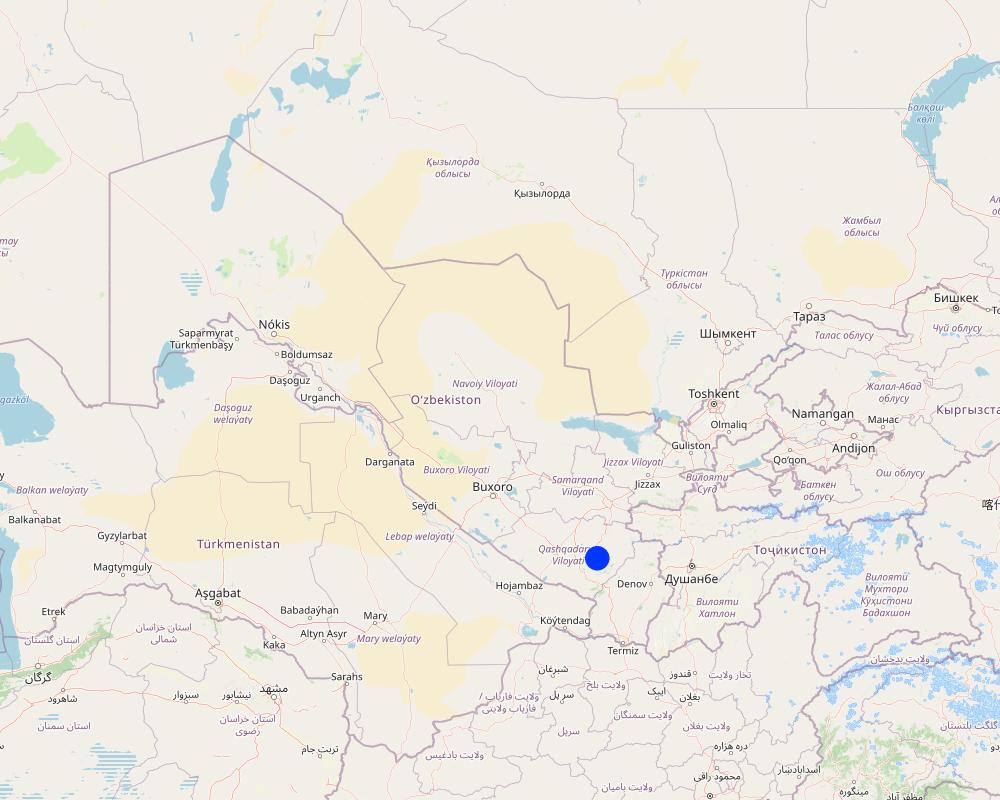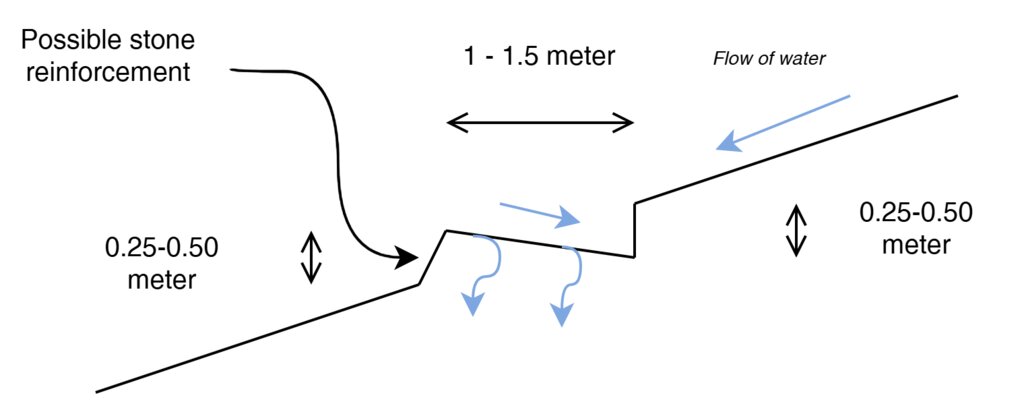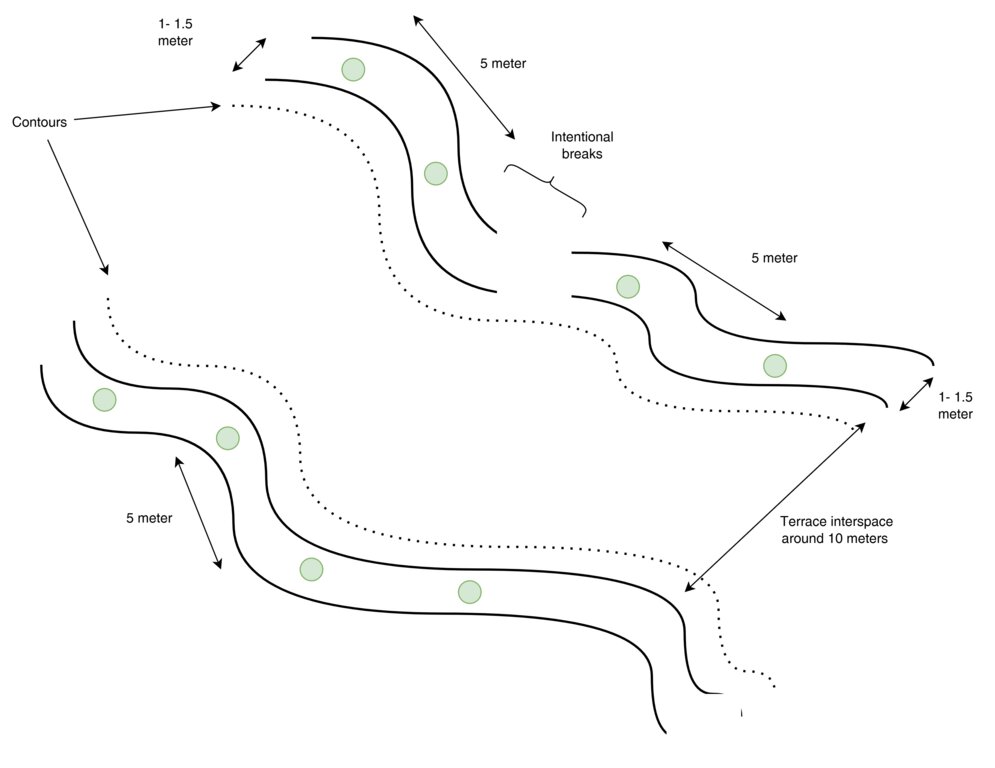Gradoni Orchard Terraces [Uzbekistan]
- Creation:
- Update:
- Compiler: Joren Verbist
- Editor: Hayot Ibrakhimov
- Reviewers: William Critchley, Rima Mekdaschi Studer
technologies_7553 - Uzbekistan
View sections
Expand all Collapse all1. General information
1.2 Contact details of resource persons and institutions involved in the assessment and documentation of the Technology
Senior Scientist Sustainable Land Management:
Akramkhanov Akmal
International Center of Agriculture Research in the Dry Areas (ICARDA)
Uzbekistan
Crop Specialist:
Fayzullayev Abdulla
International Center of Agriculture Research in the Dry Areas (ICARDA)
Uzbekistan
Water Harvesting Expert:
Ali Muddaber Mohammad
International Center of Agriculture Research in the Dry Areas (ICARDA)
Jordan
Water Harvesting Expert:
Alwidyan Jafar
International Center of Agriculture Research in the Dry Areas (ICARDA)
Jordan
Project Manager:
Nurbekov Aziz
Food and Agriculture Organization (FAO) of the United Nations
Uzbekistan
Name of project which facilitated the documentation/ evaluation of the Technology (if relevant)
ICARDA Institutional Knowledge Management InitiativeName of project which facilitated the documentation/ evaluation of the Technology (if relevant)
Food Systems, Land Use, and Restoration Impact Program in Uzbekistan (GCP/UZB/010/GFF) (FOLUR)Name of the institution(s) which facilitated the documentation/ evaluation of the Technology (if relevant)
ICARDA International Center for Agricultural Research in the Dry Areas (ICARDA) - Syrian Arab Republic1.3 Conditions regarding the use of data documented through WOCAT
The compiler and key resource person(s) accept the conditions regarding the use of data documented through WOCAT:
Yes
1.4 Declaration on sustainability of the described Technology
Is the Technology described here problematic with regard to land degradation, so that it cannot be declared a sustainable land management technology?
No
2. Description of the SLM Technology
2.1 Short description of the Technology
Definition of the Technology:
Gradoni orchard terraces are intermittent strips of contour-based structures separated by catchments of about 10 metres. They are designed to capture and hold rainwater, reduce erosion, and improve conditions for the cultivation (in this case) of almond and pistachio trees, thereby enhancing land productivity and climate resilience in dryland areas.
2.2 Detailed description of the Technology
Description:
Qashqadaryo Province in southern Uzbekistan experiences a hot, dry summer and a mild winter. Combined with unsustainable land management practices, climatic stresses have exacerbated land degradation and made local livelihoods increasingly vulnerable.
As part of the Food Systems, Land Use and Restoration (FOLUR) project, the International Center for Agricultural Research in the Dry Areas (ICARDA) designed and tested rainwater harvesting (RWH) structures to combat land degradation and enhance rural livelihoods. These RWH structures support vegetation growth, reduce surface runoff, prevent erosion, and restore soil health—thereby reversing degradation and improving agricultural productivity.
The intervention site, covering approximately 1.6 hectares, is characterized by shallow clay soils (5–25 cm deep).
Gradoni orchard terraces (“intermittent terraces” or “step terraces”) were used. These small contour-based earth structures are separated by catchments of about 10 metres. They are designed to capture and hold rainwater, reduce erosion, and improve conditions for the cultivation – in this case of almond and pistachio.
Two variations were implemented depending on the slope gradient: one with stone-reinforced risers on steep slopes (20–25%), and the other with earth risers on moderate slopes (12–19%). The terraces are sited about 10 meters apart on contour lines, and the terrace beds are only 1-1.5 metres wide and the risers 0.25-0.5 metres high. Along each back-sloping terrace bed, 5 metres spacing between trees was considered optimal.
Following site assessment, data collection, and detailed design calculations, implementation commenced. Although a grader was initially preferred for terrace construction, an older local tractor was used due to its better manoeuvrability on the steep terrain. The tractor ploughed the land using a two-mouldboard plough, after which manual labour, guided by technical experts, shaped the terraces. To accommodate natural contour variability, the terraces were not continuous – but gaps were left between them.
During a week of implementation, 25 Gradoni terraces were constructed, of which eight were stone-reinforced. Around 340 almond and pistachio trees were planted. Two workers had spent two days marking contour lines, while ten others worked for four days to finalize the terraces after the tractor had loosened the soil. The estimated lifespan of the terraces is around 20 years without maintenance, with the stone-reinforced ones expected to last even longer.
Land users expressed optimism about the prospect of improved incomes from almond and pistachio yields, especially considering the previously low or non-existent production due to severe land degradation and lack of water.
Maintenance requirements are expected to be minimal. Experts highlighted the terraces' role in capturing and retaining rainwater, which supports vegetation regeneration and contributes significantly to reversing and preventing further land degradation. By improving water availability, the intervention strengthens the community’s ability to withstand droughts, thereby securing income in the face of climate variability. The introduction of pistachio and almond cultivation provides a new and valuable source of income for local land users. These tree crops are well-suited to the arid environment and are inherently drought-resilient, making them an ideal choice for sustaining agricultural productivity under increasingly dry conditions.
Acknowledgement: This SLM was introduced by ICARDA in the framework of Food Systems, Land Use and Restoration Impact Program (FOLUR) in Uzbekistan (GCP/UZB/010/GFF), implemented by FAO with funding from the Global Environment Facility (GEF)
2.3 Photos of the Technology
2.5 Country/ region/ locations where the Technology has been applied and which are covered by this assessment
Country:
Uzbekistan
Region/ State/ Province:
Qashakadarya province
Further specification of location:
8°43'14.26"N, 66°41'51.87"E
Specify the spread of the Technology:
- evenly spread over an area
If precise area is not known, indicate approximate area covered:
- < 0.1 km2 (10 ha)
Is/are the technology site(s) located in a permanently protected area?
No
Map
×2.6 Date of implementation
Indicate year of implementation:
2024
2.7 Introduction of the Technology
Specify how the Technology was introduced:
- through projects/ external interventions
3. Classification of the SLM Technology
3.1 Main purpose(s) of the Technology
- improve production
- reduce, prevent, restore land degradation
- adapt to climate change/ extremes and its impacts
- create beneficial economic impact
- create beneficial social impact
3.2 Current land use type(s) where the Technology is applied
Land use mixed within the same land unit:
No

Cropland
- Tree and shrub cropping
- Almond and Pistachio nut trees
Comments:
There are ideas to include some crop production/cultivation between the terraces. To enhance production as well as soil conservation.
3.3 Has land use changed due to the implementation of the Technology?
Has land use changed due to the implementation of the Technology?
- Yes (Please fill out the questions below with regard to the land use before implementation of the Technology)

Grazing land
Extensive grazing:
- Semi-nomadic pastoralism
- Mixed
3.4 Water supply
Water supply for the land on which the Technology is applied:
- rainfed
3.5 SLM group to which the Technology belongs
- improved ground/ vegetation cover
- cross-slope measure
- water harvesting
3.6 SLM measures comprising the Technology

agronomic measures
- A1: Vegetation/ soil cover
- A3: Soil surface treatment
- A4: Subsurface treatment

vegetative measures
- V1: Tree and shrub cover

structural measures
- S1: Terraces
- S2: Bunds, banks
- S3: Graded ditches, channels, waterways
- S7: Water harvesting/ supply/ irrigation equipment

management measures
- M1: Change of land use type
- M2: Change of management/ intensity level
3.7 Main types of land degradation addressed by the Technology

soil erosion by water
- Wt: loss of topsoil/ surface erosion
- Wg: gully erosion/ gullying
- Wo: offsite degradation effects

soil erosion by wind
- Et: loss of topsoil
- Ed: deflation and deposition
- Eo: offsite degradation effects

physical soil deterioration
3.8 Prevention, reduction, or restoration of land degradation
Specify the goal of the Technology with regard to land degradation:
- reduce land degradation
- restore/ rehabilitate severely degraded land
4. Technical specifications, implementation activities, inputs, and costs
4.1 Technical drawing of the Technology
Technical specifications (related to technical drawing):
The Gradoni terraces are step-like structures constructed along contour lines on sloping terrain to reduce runoff, capture rainwater, and support vegetation growth. Each terrace has a horizontal width of approximately 1.0 to 1.5 meters, and is built by cutting and filling the slope to form a level planting surface and water retention/infiltration area.
The vertical cut and fill height is typically 0.25 to 0.50 meters, depending on site conditions. On steeper slopes (20–25%), the terrace face is reinforced with stones to enhance structural stability and longevity. On moderate slopes (12–19%), no stone reinforcement is required.
Annual precipitation is 200mm and plants require around 400mm.
Author:
ICARDA
Date:
2025
Technical specifications (related to technical drawing):
This top view illustrates the layout of Gradoni terraces constructed along contour lines on sloped terrain. The terraces follow the natural contours of the land to minimize runoff and maximize water retention, with dotted lines representing the contour guides used during marking.
Each terrace is approximately 1.0 to 1.5 meters wide, with around 10 meters of vertical spacing between terraces (terrace interspace). Pistachio and almond trees, selected for their drought resilience and economic value, are planted at regular 5-meter intervals along the terraces.
The drawing also includes intentional breaks in some of the terrace segments. These breaks are a precautionary measure to reduce the risk of structural damage in cases where the contour is not perfectly followed or alignment is imperfect. By interrupting the continuity, they help dissipate excess water flow and prevent erosion or collapse of terrace edges on uneven terrain.
Author:
ICARDA
Date:
2025
4.2 General information regarding the calculation of inputs and costs
Specify how costs and inputs were calculated:
- per Technology area
Indicate size and area unit:
1.6 ha
Specify currency used for cost calculations:
- USD
4.3 Establishment activities
| Activity | Timing (season) | |
|---|---|---|
| 1. | Start of field activities: Site setup, contour line marking by 2 workers | 20 September |
| 2. | Continuation of contour marking | 21 September |
| 3. | Tractor plowing using a chain tractor with 2-moldboard plow | 22 September |
| 4. | Manual terrace formation by 10 laborers; shaping and adjusting terraces | 23–26 September |
| 5. | Tree planting – approximately 340 pistachio and almond trees planted | 25–26 September |
4.4 Costs and inputs needed for establishment
| Specify input | Unit | Quantity | Costs per Unit | Total costs per input | % of costs borne by land users | |
|---|---|---|---|---|---|---|
| Labour | Contour marking | Person-days | 4.0 | |||
| Labour | Terrace shaping | Person-days | 40.0 | |||
| Labour | Stone reinforcement | Person-days | 8.0 | |||
| Labour | Tree planting | Person-days | 8.0 | |||
| Labour | Supervision | Person-days | 5.0 | |||
| Equipment | Tractor + plough/grader | Machine-Days | 2.0 | |||
| Plant material | Seedlings | Number | 340.0 | |||
| Fertilizers and biocides | Manure | kg | 1350.0 | |||
| Construction material | Stones | m3 | 120.0 | |||
| Other | total cost | 1.0 | 3200.0 | 3200.0 | ||
| Total costs for establishment of the Technology | 3200.0 | |||||
| Total costs for establishment of the Technology in USD | 3200.0 | |||||
If you are unable to break down the costs in the table above, give an estimation of the total costs of establishing the Technology:
3300.0
If land user bore less than 100% of costs, indicate who covered the remaining costs:
Project
4.5 Maintenance/ recurrent activities
| Activity | Timing/ frequency | |
|---|---|---|
| 1. | Inspections and incidental repairs | Throughout year |
4.6 Costs and inputs needed for maintenance/ recurrent activities (per year)
| Specify input | Unit | Quantity | Costs per Unit | Total costs per input | % of costs borne by land users | |
|---|---|---|---|---|---|---|
| Labour | Inspection and incidental repairs | person-days | 2.0 | 100.0 |
Comments:
It is not quantified and evidenced but 10-25% of establishment is typically considered the yearly cost of maintenance.
5. Natural and human environment
5.1 Climate
Annual rainfall
- < 250 mm
- 251-500 mm
- 501-750 mm
- 751-1,000 mm
- 1,001-1,500 mm
- 1,501-2,000 mm
- 2,001-3,000 mm
- 3,001-4,000 mm
- > 4,000 mm
Agro-climatic zone
- semi-arid
5.2 Topography
Slopes on average:
- flat (0-2%)
- gentle (3-5%)
- moderate (6-10%)
- rolling (11-15%)
- hilly (16-30%)
- steep (31-60%)
- very steep (>60%)
Landforms:
- plateau/plains
- ridges
- mountain slopes
- hill slopes
- footslopes
- valley floors
Altitudinal zone:
- 0-100 m a.s.l.
- 101-500 m a.s.l.
- 501-1,000 m a.s.l.
- 1,001-1,500 m a.s.l.
- 1,501-2,000 m a.s.l.
- 2,001-2,500 m a.s.l.
- 2,501-3,000 m a.s.l.
- 3,001-4,000 m a.s.l.
- > 4,000 m a.s.l.
Indicate if the Technology is specifically applied in:
- not relevant
5.3 Soils
Soil depth on average:
- very shallow (0-20 cm)
- shallow (21-50 cm)
- moderately deep (51-80 cm)
- deep (81-120 cm)
- very deep (> 120 cm)
Soil texture (topsoil):
- medium (loamy, silty)
Soil texture (> 20 cm below surface):
- medium (loamy, silty)
- fine/ heavy (clay)
Topsoil organic matter:
- medium (1-3%)
5.4 Water availability and quality
Ground water table:
5-50 m
Availability of surface water:
poor/ none
Water quality (untreated):
for agricultural use only (irrigation)
Water quality refers to:
both ground and surface water
Is water salinity a problem?
No
Is flooding of the area occurring?
Yes
Regularity:
episodically
5.5 Biodiversity
Species diversity:
- low
Habitat diversity:
- low
5.6 Characteristics of land users applying the Technology
Sedentary or nomadic:
- Sedentary
Market orientation of production system:
- mixed (subsistence/ commercial)
Off-farm income:
- 10-50% of all income
Relative level of wealth:
- very poor
- poor
Individuals or groups:
- individual/ household
- employee (company, government)
Level of mechanization:
- manual work
- mechanized/ motorized
Gender:
- women
- men
Age of land users:
- children
- middle-aged
Indicate other relevant characteristics of the land users:
The farmer using the land is an employee at the forestry department.
5.7 Average area of land used by land users applying the Technology
- < 0.5 ha
- 0.5-1 ha
- 1-2 ha
- 2-5 ha
- 5-15 ha
- 15-50 ha
- 50-100 ha
- 100-500 ha
- 500-1,000 ha
- 1,000-10,000 ha
- > 10,000 ha
Is this considered small-, medium- or large-scale (referring to local context)?
- small-scale
5.8 Land ownership, land use rights, and water use rights
Land ownership:
- state
- individual, titled
Land use rights:
- individual
- Water not available
Are land use rights based on a traditional legal system?
Yes
5.9 Access to services and infrastructure
health:
- poor
- moderate
- good
education:
- poor
- moderate
- good
technical assistance:
- poor
- moderate
- good
employment (e.g. off-farm):
- poor
- moderate
- good
markets:
- poor
- moderate
- good
energy:
- poor
- moderate
- good
roads and transport:
- poor
- moderate
- good
drinking water and sanitation:
- poor
- moderate
- good
financial services:
- poor
- moderate
- good
6. Impacts and concluding statements
6.1 On-site impacts the Technology has shown
Socio-economic impacts
Production
crop production
Comments/ specify:
From unproductive land, to productive land
crop quality
Comments/ specify:
Crops less affected by droughts
wood production
risk of production failure
Comments/ specify:
Drought resilient plants and better drought resilient due to rainwater harvesting
product diversity
Comments/ specify:
Almonds and Pistachios are planted
production area
Income and costs
farm income
diversity of income sources
Comments/ specify:
The harvest of the trees offers alternative income for the local population,. Pistachio and Almond provide two income sources
Socio-cultural impacts
food security/ self-sufficiency
SLM/ land degradation knowledge
Comments/ specify:
By working together with locals, their experience and knowledge in rainwater harvesting improved
situation of socially and economically disadvantaged groups
Ecological impacts
Water cycle/ runoff
harvesting/ collection of water
Comments/ specify:
Gradoni ochard terraces major function is to harvest water
surface runoff
Comments/ specify:
More water is trapped by the terraces, so there is less run-off.
Soil
soil moisture
soil cover
soil loss
Comments/ specify:
minimal to no erosion on the terraces. Erosion from the inter-spaces will be trapped by terraces hence no soil will leave the area/system.
soil accumulation
Comments/ specify:
Soil, eroded from the catchment, is trapped by the rwh structures
soil crusting/ sealing
Comments/ specify:
Growing trees that provide shade help establish vegetation cover, breaking the crusts
soil compaction
Comments/ specify:
growing root system can aerate the soil and reduce compaction
soil organic matter/ below ground C
Comments/ specify:
Expanding root system will increase below ground SOM/SOC.
Climate and disaster risk reduction
flood impacts
Comments/ specify:
More water is trapped in the catchment resulting in less flood risk.
drought impacts
Comments/ specify:
More water is captured and infiltrated making the land less susceptible to droughts
micro-climate
Comments/ specify:
The trees will provide some share which can enhance micro climates lowering temperature on surface and below
Specify assessment of on-site impacts (measurements):
Expert judgement
6.2 Off-site impacts the Technology has shown
downstream flooding
downstream siltation
wind transported sediments
damage on neighbours' fields
damage on public/ private infrastructure
Specify assessment of off-site impacts (measurements):
Expert judgement
6.3 Exposure and sensitivity of the Technology to gradual climate change and climate-related extremes/ disasters (as perceived by land users)
Gradual climate change
Gradual climate change
| Season | increase or decrease | How does the Technology cope with it? | |
|---|---|---|---|
| annual rainfall | decrease | moderately |
Climate-related extremes (disasters)
Hydrological disasters
| How does the Technology cope with it? | |
|---|---|
| flash flood | well |
Comments:
Expert judgement
6.4 Cost-benefit analysis
How do the benefits compare with the establishment costs (from land users’ perspective)?
Short-term returns:
slightly negative
Long-term returns:
very positive
How do the benefits compare with the maintenance/ recurrent costs (from land users' perspective)?
Short-term returns:
positive
Long-term returns:
very positive
Comments:
Expectations
6.5 Adoption of the Technology
- single cases/ experimental
Of all those who have adopted the Technology, how many did so spontaneously, i.e. without receiving any material incentives/ payments?
- 0-10%
6.6 Adaptation
Has the Technology been modified recently to adapt to changing conditions?
No
6.7 Strengths/ advantages/ opportunities of the Technology
| Strengths/ advantages/ opportunities in the land user’s view |
|---|
| Gradoni terraces provide a stable planting bed ideal for perennial, drought-resistant tree crops like pistachio and almond. These trees not only stabilize the soil further but also offer long-term income opportunities, enhancing both ecological resilience and rural livelihoods. |
| Strengths/ advantages/ opportunities in the compiler’s or other key resource person’s view |
|---|
| By breaking the slope into small, level steps, Gradoni terraces significantly reduce the velocity of surface runoff. This minimizes soil erosion and helps restore degraded lands, especially on sloping terrain, making previously unproductive land usable again. |
| Gradoni terraces capture and slow down rainwater runoff, allowing it to infiltrate into the soil rather than flow away. This increases soil moisture availability, which is especially critical in arid and semi-arid environments, supporting better plant growth and reducing drought vulnerability. |
6.8 Weaknesses/ disadvantages/ risks of the Technology and ways of overcoming them
| Weaknesses/ disadvantages/ risks in the land user’s view | How can they be overcome? |
|---|---|
| The construction of terraces—especially on steep slopes with stone reinforcement—can require significant manual labor and materials upfront. | Expand over time |
| Weaknesses/ disadvantages/ risks in the compiler’s or other key resource person’s view | How can they be overcome? |
|---|---|
| If terraces are not properly aligned with contour lines, water may concentrate and cause erosion or structural failure. | Introduce intentional breaks in the terrace line, as done in this project, to relieve pressure where alignment may be imperfect. |
| The construction of terraces—especially on steep slopes with stone reinforcement—can require significant manual labor and materials upfront. | Mobilize community participation and use local labor to reduce costs. |
7. References and links
7.1 Methods/ sources of information
- field visits, field surveys
- interviews with land users
- interviews with SLM specialists/ experts
- compilation from reports and other existing documentation
When were the data compiled (in the field)?
2025
7.3 Links to relevant online information
Title/ description:
Oweis, T. and Haddad, M. 2023. Rainwater Harvesting Design Manual: Micro-catchment Systems for Drylands Agriculture. Lebanon, Beirut: International Center for Agricultural Research in the Dry Areas (ICARDA).
URL:
https://hdl.handle.net/10568/169777
Title/ description:
Sheng, T. C. (1989). Soil conservation for small farmers in the humid tropics (FAO Soils Bulletin). Food and Agriculture Organization of the United Nations.
URL:
https://ia601300.us.archive.org/6/items/bub_gb_uLX80osg3rUC/bub_gb_uLX80osg3rUC.pdf
Title/ description:
Critchley, W. & Siegert, K., (1991). Water Harvesting: A Manual for the Design and Construction of Water Harvesting Schemes for Plant Production. Rome: Food and Agriculture Organisation, Rome
URL:
https://www.fao.org/3/U3160E/U3160E00.htm
Links and modules
Expand all Collapse allLinks
No links
Modules
No modules


